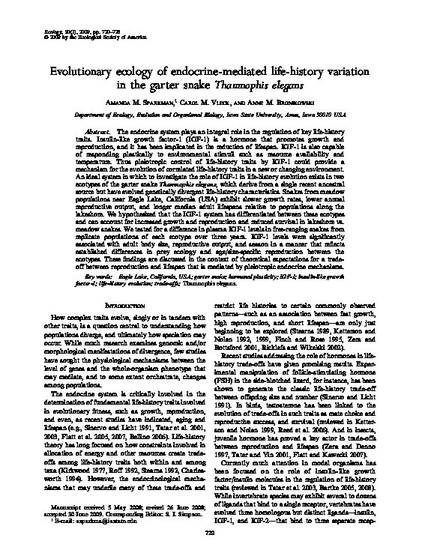
Article
Evolutionary ecology of endocrine-mediated life-history variation in the garter snake Thamnophis elegans
Ecology
Document Type
Article
Disciplines
Publication Version
Published Version
Publication Date
3-1-2009
DOI
10.1890/08-0850.1
Abstract
The endocrine system plays an integral role in the regulation of key life-history traits. Insulin-like growth factor-1 (IGF-1) is a hormone that promotes growth and reproduction, and it has been implicated in the reduction of lifespan. IGF-1 is also capable of responding plastically to environmental stimuli such as resource availability and temperature. Thus pleiotropic control of life-history traits by IGF-1 could provide a mechanism for the evolution of correlated life-history traits in a new or changing environment. An ideal system in which to investigate the role of IGF-1 in life-history evolution exists in two ecotypes of the garter snake Thamnophis elegans, which derive from a single recent ancestral source but have evolved genetically divergent life-history characteristics. Snakes from meadow populations near Eagle Lake, California (USA) exhibit slower growth rates, lower annual reproductive output, and longer median adult lifespans relative to populations along the lakeshore. We hypothesized that the IGF-1 system has differentiated between these ecotypes and can account for increased growth and reproduction and reduced survival in lakeshore vs. meadow snakes. We tested for a difference in plasma IGF-1 levels in free-ranging snakes from replicate populations of each ecotype over three years. IGF-1 levels were significantly associated with adult body size, reproductive output, and season in a manner that reflects established differences in prey ecology and age/size-specific reproduction between the ecotypes. These findings are discussed in the context of theoretical expectations for a trade-off between reproduction and lifespan that is mediated by pleiotropic endocrine mechanisms.
Rights
Copyright by the Ecological Society of America
Copyright Owner
Ecological Society of America
Copyright Date
2009
Language
en
File Format
application/pdf
Citation Information
Amanda M. Sparkman, Carol M. Vleck and Anne M. Bronikowski. "Evolutionary ecology of endocrine-mediated life-history variation in the garter snake Thamnophis elegans" Ecology Vol. 90 Iss. 3 (2009) p. 720 - 728 Available at: http://works.bepress.com/carol-vleck/6/

This article is from Ecology 90 (2009); 720, doi: 10.1890/08-0850.1. Posted with permission.